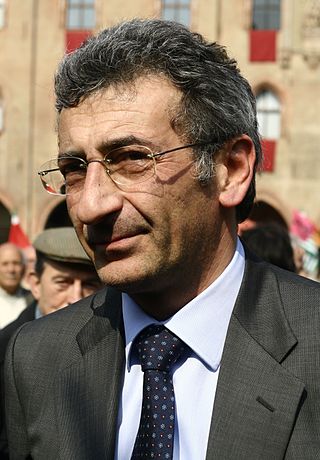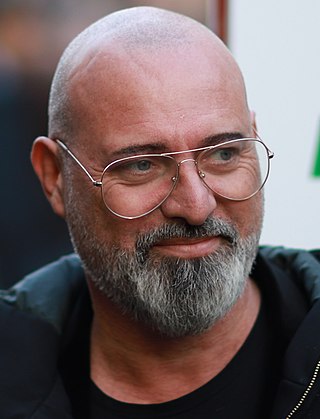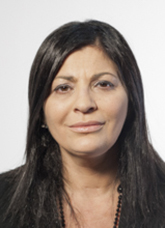
A snap election was held in Italy on 13–14 April 2008. The election came after President Giorgio Napolitano dissolved the Italian Parliament on 6 February 2008, following the defeat of the government of Prime Minister Romano Prodi in a January 2008 Senate vote of confidence and the unsuccessful tentative appointment of Franco Marini with the aim to change the current electoral law. Under Italian law, elections must be held within 70 days of the dissolution. The voting determined the leader of Italy's 62nd government since the end of World War II. The coalition led by ex-Prime Minister Silvio Berlusconi from The People of Freedom party defeated that of former Mayor of Rome, Walter Veltroni of the Democratic Party.

The politics of Emilia-Romagna, a region of Italy, takes place in a framework of a presidential representative democracy, whereby the President of Regional Government is the head of government, and of a pluriform multi-party system. Executive power is exercised by the Regional Government. Legislative power is vested in both the government and the Legislative Assembly.

The Emilia-Romagna regional election of 2005 took place on 3–4 April 2005.

The Emilia-Romagna regional election of 2000 took place on 16 April 2000.

The Sardinian regional election of 1994 took place on 12 and 26 June 1994.

The Emilia-Romagna regional election of 1995 took place on 23 April 1995.

The 2010 Lombard regional election took place on 28–29 March 2010. The 9th term of the Regional Council was chosen.

The Emilia-Romagna regional election of 2010 took place on 28–29 March 2010.

The Mayor of Bologna is an elected politician who, along with the Bologna’s City Council, is accountable for the strategic government of Bologna, the regional capital of Emilia-Romagna, Italy.

Vasco Errani is an Italian politician. He was a founding member of the Democratic Party (PD), which he has left on 22 February 2017, to join Article 1 – Democratic and Progressive Movement, a party founded by the former PD left-wing minority. He has been President of Emilia-Romagna from 1999 to 2014, being the longest-serving one of all time. Errani is one of the longest-serving governors in the history of the Italian Republic.

Stefano Bonaccini is an Italian politician and member of the Democratic Party (PD), of which he is serving as president since 12 March 2023. In 2024, he was elected to the European Parliament to represent North-East Italy.

Municipal elections were held in Bologna on 6–7 and 21–22 June 2009. The centre-left candidate Flavio Delbono was elected mayor at the second round with 60.77% of votes.
The Italian electoral law of 2017, colloquially known by the nickname Rosatellum after Ettore Rosato, the Democratic Party (PD) leader in the Chamber of Deputies who first proposed the new law, is a parallel voting system, which acts as a mixed electoral system, with 37% of seats allocated using a first-past-the-post electoral system and 63% using a proportional method, with one round of voting. The Chamber and Senate of the Republic did not differ in the way they allocated the proportional seats, both using the largest remainder method of allocating seats.

The 2019 Sardinian regional election took place in this Italian region on 24 February 2019. The election was for all 59 elected seats of the Regional Council of Sardinia as well as the President of the Region who, along with the second placed presidential candidate, would also become members of the Regional Council.

The 2020 Emilia-Romagna regional election took place in Emilia-Romagna, Italy, on 26 January 2020. The result was the victory of the centre-left coalition and the confirmation of Stefano Bonaccini as President of Emilia-Romagna, with more than 51% of votes, nearly doubling the number of votes received in 2014.

The 2020 Calabrian regional election took place in Calabria, Italy, on 26 January 2020. The result was the victory of the centre-right coalition and the election of Jole Santelli as President of Calabria.

The 2020 Apulian regional election took place in Apulia, Italy, on 20 and 21 September. It was originally scheduled to take place on May 31, 2020, but it was delayed due to the COVID-19 pandemic in Italy.

The municipal elections in Bologna took place on 3 and 4 October 2021. The incumbent Mayor of Bologna was Virginio Merola of Democratic Party, who won the 2016 Bologna municipal election. The centre-left candidate Matteo Lepore won in a landslide with 62% of votes, becoming the most voted mayor since the introduction of direct elections in 1995.

The 2024 Emilia-Romagna regional election took place in Emilia-Romagna, Italy, on 17–18 November 2024.




















